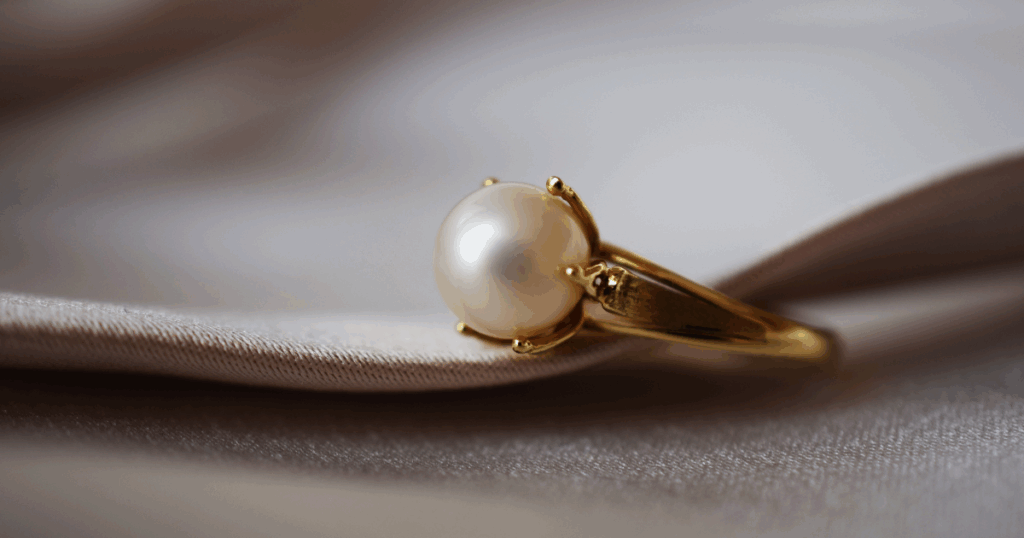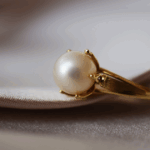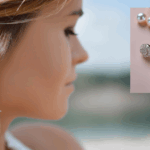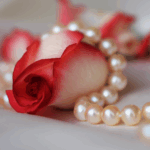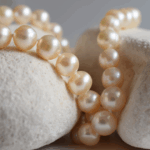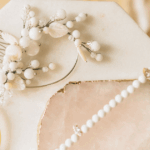Beyond the Diamond: Your Custom Pearl Ring
Ready for a ring as unique as your love story?
A custom pearl engagement ring is a bespoke piece of jewelry meticulously designed around a central pearl, chosen for its unique luster and profound sentimental value. It offers a deeply personal and elegant alternative to traditional rings, empowering you to influence every single detail—from the specific pearl and its origin to the intricate metalwork of the setting. This collaborative process results in a one-of-a-kind symbol of your commitment, a true heirloom in the making.
The Allure of the Ocean’s Gem: Why Choose a Pearl?
Choosing an engagement ring is, without a doubt, one of the most sentimental purchases you’ll ever make. For decades, the diamond has been the default, the undisputed champion of proposals. But what if your love story feels… different? What if it’s less about fiery brilliance and more about a quiet, luminous glow? Enter the pearl. Opting for a pearl is a declaration of individuality, a nod to timeless elegance, and a choice steeped in profound meaning. It’s for the couple who charts their own course, valuing personal significance over loud tradition. The decision to commission a bespoke pearl ring is a journey into creating something that doesn’t just sit on a finger but tells a story—your story. It’s about embracing a gem that is born of a living creature, a miracle of the deep, making it feel more organic, more connected to life itself. This choice whispers romance rather than shouts it, promising a future built on wisdom, integrity, and a beauty that radiates from within.
A Symbol of Purity, Wisdom, and Enduring Love
Long before diamonds cornered the market, pearls were the ultimate symbol of wealth, power, and love. Ancient cultures revered them as “teardrops of the moon” or gifts from the gods. In ancient Rome, pearls were considered the ultimate status symbol, while Greek mythology held that these oceanic gems were the hardened tears of joy shed by the goddess Aphrodite. This rich tapestry of lore imbues the pearl with a significance that transcends mere adornment. Unlike gems mined from the earth, a pearl is created by a living organism—a patient, layered process of creating beauty in response to an irritant. What a powerful metaphor for a strong relationship, right? It symbolizes the beauty that can emerge from challenges, growing stronger and more luminous over time. Choosing a pearl is tapping into this ancient current of symbolism. It represents purity of heart, integrity, and the wisdom gained through experience. For a couple starting their life together, it’s a beautiful emblem of a love that is pure, grows over time, and is built on a foundation of shared wisdom and loyalty. It’s a classic choice that feels both ancient and refreshingly modern.
Breaking Tradition: The Modern Appeal of Uniqueness
Today’s couples are rewriting the rulebook on weddings and engagements. The pressure to conform to a “one-size-fits-all” vision of love is fading, replaced by a celebration of authenticity and personal expression. This societal shift is beautifully reflected in the rising popularity of non-traditional engagement rings, with the custom pearl ring leading the charge. Why? Because customization is the ultimate form of personal expression. It’s a collaborative art form between you and a skilled artisan to create an object that is imbued with your personality, your memories, and your shared dreams. You’re not just picking a ring from a display case; you’re involved in its very conception. This process resonates deeply with a generation that values experiences over possessions and stories over status symbols. The appeal lies in knowing that no other ring in the world will be exactly like yours. Your choice of a Tahitian pearl might reflect a memorable trip, or a baroque pearl might celebrate your love for perfect imperfections. A custom pearl engagement ring is a quiet rebellion against the expected, a testament to a love that is confident, understated, and deeply personal. It says you value a different kind of preciousness—one based on meaning, not just a carat weight.
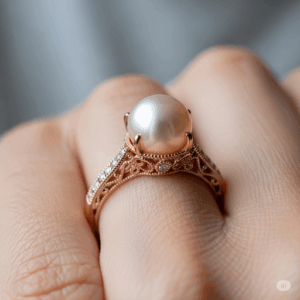
The Anatomy of Your Dream Ring: Deconstructing the Elements
Embarking on the custom ring journey is like being the architect of your own romantic symbol. It’s an exciting process, but it helps to understand the fundamental building blocks you’ll be working with. Think of it in three main parts: the heart of the ring (the pearl), the body (the metal band and setting), and the soul (the overall design). Each element plays a crucial role in the final piece’s beauty, durability, and character. Getting familiar with these components empowers you to make informed decisions and communicate your vision clearly to your jeweler. You’ll move from vague ideas like “I want something vintage” to specific desires like “I envision a luminous Akoya pearl in a delicate, milgrain-detailed bezel setting made of 14k yellow gold.” This section is your guide to the essential anatomy of your future heirloom, breaking down the key choices you’ll make along the way. From the hypnotic depths of a Tahitian pearl to the warm embrace of rose gold, let’s explore the materials that will form your one-of-a-kind ring.
Selecting the Perfect Pearl: A Deep Dive into Types
The pearl is the star of the show, and its personality will define your ring. Not all pearls are created equal; they come from different parts of the world, different oysters, and have distinctly different characteristics. Understanding these types is the first, most exciting step.
- Akoya Pearls: The quintessential classic. Hailing primarily from Japan and China, Akoya pearls are famed for their near-perfect round shape and exceptionally high, mirror-like luster. They typically come in shades of white or cream, often with overtones of rose, silver, or cream. If you envision a timeless, perfectly round, and brilliantly shiny pearl, the Akoya is likely your muse. They are the go-to for traditional elegance.
- South Sea Pearls: The epitome of luxury. Cultivated in the warm waters of Australia, Indonesia, and the Philippines, these are the largest and rarest of all cultured pearls. Their colors are enchanting, ranging from a silky, opulent white to a deep, honey gold. Their luster is softer and more satiny than the Akoya’s, giving them a subtle, sophisticated glow. A South Sea pearl makes a bold, luxurious statement.
- Tahitian Pearls: The exotic and mysterious choice. Often called “black pearls,” these gems from French Polynesia boast a breathtaking spectrum of colors. They range from metallic silver and graphite to pistachio green, deep aubergine, and peacock, often with mesmerizing overtones. No two Tahitian pearls are exactly alike, making them perfect for a ring that celebrates uniqueness and drama.
- Freshwater Pearls: The versatile and accessible option. Cultivated in lakes and rivers, primarily in China, modern freshwater pearls offer an incredible range of shapes, sizes, and natural pastel colors like lavender, pink, and peach, in addition to white. While historically less round than Akoya pearls, advancements in cultivation have produced stunningly round, lustrous freshwater pearls that offer exceptional value, allowing for more creativity in design and size without breaking the bank.
The GIA’s Seven Pearl Value Factors™ Explained
When you start looking at pearls, you’ll hear jewelers talk about quality. To understand what they mean, it helps to know the universal standard used by experts: the Gemological Institute of America (GIA)’s 7 Pearl Value Factors™. This framework helps you objectively assess a pearl and understand its price. Think of it as the pearl equivalent of the 4Cs for diamonds.
- Size: Measured in millimeters, the larger the pearl, the rarer and more valuable it generally is, assuming all other factors are equal.
- Shape: Round is the most classic and often most valuable shape. However, other shapes like near-round, oval, button, drop, and especially unique baroque (irregularly shaped) pearls are highly prized in custom designs for their character.
- Color: This includes the main bodycolor (e.g., white, black, gold), the overtone (a subtle secondary color on the surface), and orient (the iridescent rainbow of colors that seems to move across the surface).
- Luster: This is perhaps the most important factor. Luster is the intense glow that comes from within the pearl, created by light reflecting through its many layers of nacre. Excellent luster is sharp, bright, and reflective. Poor luster is dull, chalky, and lifeless.
- Surface: A pearl’s surface is rarely flawless. Look for any blemishes like pits, bumps, or spots. The cleaner the surface, the more valuable the pearl.
- Nacre Quality: Nacre is the crystalline substance the oyster secretes to form the pearl. Thick, high-quality nacre ensures good luster and durability. You want to avoid pearls with thin nacre, which can look chalky and are prone to chipping.
- Matching: For jewelry with multiple pearls, like earrings or strands, this refers to how well the pearls match in all the other value factors. For a single-pearl engagement ring, this factor is not applicable.
Understanding these factors helps you appreciate the nuances of the pearl you choose and ensures you’re getting a quality gem. You can learn more about these factors directly from the source at the GIA’s official website.
Choosing Your Metal: Gold, Platinum, and Beyond
The metal you choose for the band and setting does more than just hold the pearl; it sets the entire mood of the ring. It’s the supporting actor that can make the star shine even brighter. Your choice will affect the ring’s color palette, durability, and cost.
- Yellow Gold (14k or 18k): The timeless, warm choice. Yellow gold creates a beautiful, classic contrast, especially with white pearls, and it harmonizes wonderfully with golden South Sea pearls. 14k gold is a great balance of durability and color, while 18k gold is richer in color but slightly softer. It evokes a sense of tradition and vintage charm.
- White Gold (14k or 18k): A modern and versatile option. White gold is an alloy of gold and white metals like palladium or nickel, plated with rhodium for a bright, silvery-white finish. It provides a crisp, contemporary look that complements the cool overtones of many Akoya, Tahitian, and white South Sea pearls. It requires re-plating every few years to maintain its brightness.
- Rose Gold (14k or 18k): The romantic, trendy favorite. An alloy of gold and copper, rose gold has a warm, pinkish hue that is incredibly flattering on most skin tones. It imparts a vintage, romantic feel and looks stunning with creamy white, pink freshwater, or even golden South Sea pearls. Its unique color makes a gentle yet distinct statement.
- Platinum: The king of white metals. Platinum is the most durable and prestigious choice. It’s naturally hypoallergenic and has a rich, silvery-white color that will never fade or change. Its density provides a reassuring weight and its strength makes it ideal for securing gems, though it comes at a higher price point. It’s the ultimate choice for a “forever” ring meant to be passed down through generations.
The Customization Journey: From Vision to Reality
This is where the magic truly happens. Creating a custom ring is a deeply personal and rewarding experience, a dance of collaboration between your vision and the jeweler’s expertise. It’s more than a transaction; it’s a creative project that culminates in a wearable piece of art. The process can be broken down into a series of exciting steps, each one bringing you closer to the finished piece. From the initial spark of an idea to the final polish, you are an integral part of the creation. This journey ensures that every curve of the metal, every detail in the setting, and the very choice of the central gem is a direct reflection of your taste and your story. It demystifies the art of jewelry making, inviting you into the workshop, figuratively or literally, to witness your dream taking shape. Let’s walk through the typical stages of this incredible process.
Step 1: Finding Your Artisan Jeweler
This is arguably the most crucial step. The right jeweler is more than a salesperson; they are your guide, translator, and skilled craftsperson. Don’t rush this. Look for a jeweler who specializes in custom work and, ideally, has experience with pearls. Start by searching online portfolios and reading reviews. Look for a consistent aesthetic that resonates with you. Are their designs delicate and intricate, or bold and modern? When you find a few candidates, schedule a consultation. This initial meeting is like a first date. You’re looking for good chemistry. Do they listen intently to your ideas? Do they ask thoughtful questions? A great custom jeweler will be excited by your vision and offer constructive suggestions to enhance it, especially regarding the practicalities of setting a softer gem like a pearl. Ask to see examples of their work in person. Feel the weight and finish of their pieces. A passionate, skilled artisan will make the entire process feel exciting and collaborative, not intimidating.
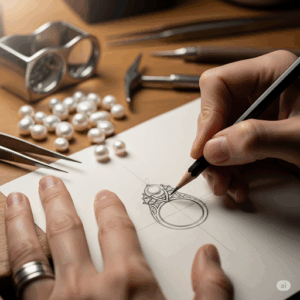
Step 2: The Consultation and Design Sketch
Once you’ve chosen your jeweler, the real fun begins. The design consultation is a deep conversation about your vision. Bring all your inspiration with you—Pinterest boards, photos of rings you love, sketches (no matter how rough!), and even stories or concepts you want the ring to represent. Maybe you want the band to twist like vines to represent your love of nature, or you want tiny hidden details that only you and your partner know about. This is the time to share it all. Your jeweler will listen and translate your abstract ideas into tangible design concepts. They will sketch out initial ideas, showing you how different elements might look together. They will also provide crucial guidance, explaining how a particular setting might affect the pearl’s safety or how a certain metal choice will influence the overall aesthetic. This is a back-and-forth conversation. You’ll refine the sketches together until you land on a design that makes your heart leap. This approved sketch becomes the blueprint for your ring.
Step 3: From CAD Model to Wax Casting
With the design finalized, technology often steps in to provide an incredibly precise preview. Most modern jewelers will create a Computer-Aided Design (CAD) model of your ring. This is a 3D digital rendering that you can view from every angle. It’s a game-changer because it allows you to see the exact proportions, clearances, and details of your ring before any metal is cast. You can request minor tweaks at this stage—perhaps making the band slightly thinner or adjusting the height of the setting. Once you approve the CAD model, the file is used to 3D print a perfect wax or resin model of your ring. Holding this physical model in your hands is a surreal moment; it’s the first time your ring truly exists in three-dimensional space. It allows you to check the scale and feel of the ring on your finger. This step eliminates any guesswork and ensures the final piece will be exactly what you envisioned before the precious metal is committed.
Step 4: Setting the Stone and Final Polish
This is the final, masterful stage where your ring truly comes to life. After you approve the wax model, it’s used to create a mold for the casting process. Molten metal—your chosen gold or platinum—is poured into the mold to create the raw casting of your ring. An incredible amount of handwork follows. The jeweler will meticulously clean up the casting, file and sand the surfaces, and prepare the setting for the pearl. Setting the pearl is a delicate and highly skilled operation. The jeweler must secure the gem perfectly, ensuring it’s not too tight (which could damage it) or too loose. Any accent stones are also set at this stage. Finally, the ring undergoes a multi-step polishing process to bring out the brilliant shine of the metal. When the jeweler presents you with the finished piece, it’s a breathtaking moment—the culmination of your vision and their skill, a tangible symbol of your love, ready for its forever home.
Designing for Durability: Protecting Your Precious Pearl
Let’s address the elephant in the room: pearls are soft. This is a fact, and it’s one that requires thoughtful design, not fear. While a pearl engagement ring isn’t as indestructible as a diamond or sapphire, millions of people have worn them for generations with the right care and, crucially, the right design. Designing for durability is about making smart, intentional choices that build a fortress of beauty around your precious gem. It’s about creating a ring that is meant for a lifetime of love, not just for a special occasion. By understanding the vulnerabilities of a pearl, you and your jeweler can work together to mitigate risks through clever setting choices and structural support. This proactive approach ensures your ring is not just stunningly beautiful but also practical for the realities of daily life. It’s the key to wearing your unique ring with confidence and peace of mind, knowing it was built to last.
Understanding the Mohs Scale: A Reality Check
The Mohs scale of mineral hardness is a simple but effective way to understand a gem’s resistance to scratching. It ranks minerals from 1 (Talc) to 10 (Diamond). Pearls land at a delicate 2.5 to 4.5 on this scale. To put that in perspective, a fingernail is about a 2.5, and a steel file is a 6.5. This means that everyday objects like keys, countertops, and even abrasive dust can scratch the surface of a pearl. This doesn’t mean a pearl is unsuitable for an engagement ring; it just means it demands respect and a different kind of mindset. You wouldn’t wear your finest silk dress to go hiking, and similarly, you wouldn’t wear your pearl ring while gardening or working out. Understanding its softness is the first step toward protecting it. It empowers you to make conscious choices about when to wear it and, more importantly, informs the structural design of the ring itself to provide as much inherent protection as possible.
Smart Setting Choices: Bezels, Halos, and Protective Designs
The setting is your pearl’s first line of defense. While a classic prong setting that lifts a diamond high is beautiful, it leaves the girdle of the stone exposed. For a pearl, this can be a risky choice. Instead, consider settings that prioritize security.
- Bezel Setting: This is the most secure option. A thin rim of metal wraps all the way around the pearl’s circumference, holding it snugly in place and protecting its edges from knocks and bumps. A full bezel offers maximum protection, while a half-bezel can be a stylish compromise, protecting the most exposed sides.
- Halo Setting: A halo of smaller, harder gemstones (like diamonds or sapphires) encircling the pearl serves a dual purpose. It adds a spectacular visual frame and, more importantly, acts as a protective bumper, absorbing impacts before they can reach the pearl.
- Lower Profile Designs: Avoid very high settings that can easily catch on things. A design that sets the pearl lower to the finger is inherently safer. Your jeweler can design a “basket” or “gallery” underneath the pearl that is both beautiful and structurally sound, keeping it from sitting too high.
- V-Prongs or Corner Prongs: For non-round pearls, like a drop or marquise shape, using v-shaped prongs to protect the vulnerable pointed tips is a very smart design choice.
Accent Stones: Adding Sparkle and Security
Incorporating harder accent stones is not just an aesthetic choice; it’s a brilliant strategic move. By flanking the pearl with small diamonds, sapphires, or other durable gems, you create a beautiful buffer zone. These tiny bodyguards can be set slightly higher than the pearl’s surface, ensuring that if your hand brushes against a surface, the harder accent stones take the brunt of the contact. This can be done in a multitude of styles. You could have a classic three-stone ring with small diamonds on either side of the pearl. You could have tiny pavé-set diamonds along the band, leading up to the pearl. Or you could have a more intricate, nature-inspired design where metal “leaves” or “vines” are studded with tiny diamonds that curl up to protect the sides of the pearl. This integration of beauty and function is the hallmark of a well-designed custom piece, giving you that coveted sparkle while simultaneously adding an invisible layer of security for your treasured center stone.
The Language of Style: Finding Your Ring’s Personality
Every ring tells a story, and its style is the language it uses. Are you a romantic soul drawn to the intricate details of a bygone era? A modernist who craves clean lines and sleek simplicity? Or a free spirit who finds beauty in the untamed, organic forms of nature? Your engagement ring is a daily reflection of your personal aesthetic, so its style should feel like a natural extension of you. The beauty of a custom design process is that you’re not limited to what’s in a catalog; you can borrow elements from different styles to create a unique fusion that is entirely your own. For those who value the past, exploring collections of classic pearl jewelry can be a fantastic source of inspiration. Seeing how pearls have been celebrated throughout history can spark incredible ideas. For instance, the timeless elegance showcased at Vintage Pearl Necklace can help you visualize how different pearl types and classic settings come together, providing a rich visual library as you define your ring’s unique personality.
Vintage and Art Deco Inspired Pearl Rings
There is an undeniable romance to vintage-inspired designs. They carry the grace and elegance of the past into the present.
- Art Nouveau (c. 1890-1910): This style is all about flowing, organic lines inspired by nature. Think asymmetrical designs, curving vines, flowers, and insects. A custom Art Nouveau ring might feature a pearl as the center of a metal lily or nestled within gracefully swirling stems.
- Edwardian (c. 1901-1910): Characterized by its delicate, light, and airy feel. This era loved platinum, intricate lacework, milgrain detailing (tiny beads of metal along the edges), and feminine motifs like bows, ribbons, and garlands. A custom Edwardian-style ring would be the epitome of refined, aristocratic elegance, perfect for a luminous Akoya pearl.
- Art Deco (c. 1920-1935): In stark contrast to the styles before it, Art Deco is all about bold geometry, sharp lines, and symmetry. Think octagonal halos, step-cut accent stones (like baguettes), and strong, architectural forms. A custom Art Deco pearl ring is perfect for someone who loves a bold, glamorous, and sophisticated look. It pairs exceptionally well with the dramatic color of a Tahitian pearl.
Modern Minimalism: Sleek and Contemporary Designs
For the lover of “less is more,” a modern minimalist design puts the focus squarely on the beauty of the materials themselves. This style is not about a lack of design, but about intentional, powerful simplicity. The philosophy here is to strip away all that is unnecessary to reveal the essential beauty of the form. Think clean lines, uncluttered surfaces, and a focus on shape and texture. A minimalist pearl ring might feature a single, perfect pearl in a sleek bezel setting on a simple, highly polished band. Or perhaps a “floating” pearl design where the pearl appears to be suspended between the two ends of the band. Satin or brushed finishes on the metal can create a soft, contemporary contrast to the pearl’s luster. This style is confident, understated, and incredibly chic. It’s perfect for the person with a strong sense of self who doesn’t need fuss or frills to make a statement.
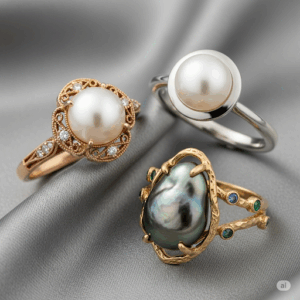
Bohemian and Nature-Inspired Creations
If your style is more free-spirited, earthy, and whimsical, a bohemian or nature-inspired design will capture your heart. This style moves away from rigid symmetry and embraces the beautiful, perfect imperfections of the natural world. It’s a celebration of texture, organic forms, and a deep connection to the earth (and sea!). A nature-inspired ring might feature a twig-like band, cast from an actual twig to capture its natural texture. It could have tiny, hand-carved leaves unfurling around the pearl, or a band with a hammered finish that mimics the surface of water. Baroque pearls, with their unique, irregular shapes, are the superstars of this style. A custom ring could be designed specifically to follow the unique contours of a specific baroque pearl, making it a truly one-of-a-kind piece of wearable sculpture. These designs feel personal, grounded, and full of life, perfect for the artistic soul who walks their own path.
Budgeting for Your Bespoke Beauty
Talking about money can feel less romantic, but establishing a clear budget is one of the most practical and empowering steps you can take. It allows you and your jeweler to work within realistic parameters to create the most beautiful ring possible for your investment. A custom ring isn’t necessarily more expensive than a pre-made one; in fact, it often offers better value because you’re paying for craftsmanship and materials, not brand marketing or retail overhead. The beauty of the custom process is its flexibility. You have direct control over the elements that influence the final cost, allowing you to allocate your budget towards what matters most to you. Whether it’s a larger, higher-quality pearl or a more intricate, labor-intensive setting, you get to decide where your money goes. A transparent conversation about budget with your jeweler from the very beginning is key to a smooth and enjoyable process, preventing any surprises and ensuring you end up with a ring you love at a price you’re comfortable with.
What Influences the Cost of a Custom Pearl Ring?
The final price of your ring is a sum of its parts and the labor required to assemble them. Understanding these key cost drivers will help you navigate the design process effectively.
- The Pearl: This is often the most significant variable. The cost is determined by the GIA’s 7 Value Factors. A large, perfectly round, clean, high-luster South Sea pearl will be the most expensive. A beautiful, slightly off-round freshwater pearl will be the most affordable. This is where you can make major adjustments to your budget. You might opt for a smaller Akoya with exceptional luster over a larger one with average luster.
- The Metal: The choice of metal impacts the price significantly. Generally, 14k gold is the most budget-friendly option, followed by 18k gold. Platinum is the most expensive due to its rarity, density, and the higher level of skill required to work with it. The total weight of metal used also matters—a wide, heavy band will cost more than a thin, delicate one.
- The Complexity of the Design: A simple solitaire ring will be less expensive to create than a highly intricate design with pavé-set diamonds, detailed engraving, and complex metalwork. The cost is directly related to the amount of time and skill the jeweler must invest. A complex, hand-carved piece will command a higher price than a simpler cast design.
- Accent Stones: The quantity, size, and quality of any diamonds or other gemstones used in the design will add to the overall cost.
- The Jeweler’s Fee: This covers the jeweler’s time, expertise, design work, and overhead. It’s a reflection of their skill and reputation. Remember, with custom work, you are paying for an artist’s time and talent, which is an invaluable part of the final piece.
Caring for Your Custom Pearl Engagement Ring
Your custom pearl ring is a treasure, and with a little mindful care, it will remain beautiful for a lifetime and beyond. As we’ve discussed, pearls are organic gems and are softer than most other stones. This just means they require a gentler touch. The most important part of pearl care is prevention. By creating good habits from day one, you can drastically minimize the risk of damage and keep its luster shining bright for years to come. Think of it as a small, daily ritual of love for a ring that symbolizes so much. It’s not complicated or time-consuming; it’s just about being conscious. These simple practices will become second nature, ensuring your oceanic gem remains as captivating as the day you first saw it.
The “Last On, First Off” Rule and Daily Care
This is the golden rule of pearl care. Your pearl ring should be the last thing you put on after getting ready and the first thing you take off when you get home. Why? Pearls are vulnerable to chemicals. Hairspray, perfume, lotion, and makeup contain chemicals that can eat away at the nacre, permanently dulling your pearl’s luster. By putting your ring on last, you avoid spraying it directly. When you take it off, gently wipe it with a soft, dry, or slightly damp microfiber cloth to remove any skin oils or residues it may have picked up during the day. Never use harsh chemical cleaners, ultrasonic cleaners, or steam cleaners, as these will destroy your pearl. Store it separately from other jewelry in a soft pouch or a fabric-lined box to prevent it from being scratched by harder gemstones like diamonds. Following this simple routine is the single most effective thing you can do to preserve its beauty. As the famous historian Suetonius might have put it, pearls hold a special place in history, and yours deserves the same reverence.
Making it Truly Yours: Engravings and Personal Touches
The visual design of your ring is only part of its story. The most profound elements are often the ones that are hidden, the secret details that infuse the piece with personal meaning. Engravings and other subtle touches transform a beautiful object into a sacred talisman of your relationship. This is where you can embed your own secret language into the very fabric of the ring. It’s an opportunity to go beyond aesthetics and add a layer of pure sentiment that only you and your partner may ever know exists. These personalizations are the soul of the ring, a constant, private reminder of the promises made and the love you share. They ensure the ring is not just custom-made in its form, but custom-made for your hearts.
Beyond the Visuals: Adding Sentimental Value
An engraving inside the band is a classic and beautiful way to personalize your ring. But don’t feel limited to just your initials and the date. Think about what is uniquely yours as a couple. It could be the coordinates of where you first met, a short line from “your song,” a shared private joke, a single meaningful word, or a symbol that represents your bond. Some couples opt for a “secret stone” set on the inside of the band—a tiny, flush-set birthstone of their partner, for example. Another beautiful idea is to have your partner’s fingerprint engraved on the inside of the band. Your jeweler can also incorporate subtle design elements with hidden meanings—perhaps a certain number of leaves on a vine to represent the years you’ve been together, or a tiny, hidden symbol under the main setting. These intimate details are what elevate a custom ring from a piece of jewelry to a true heirloom.
The Grand Reveal: Proposing with a Pearl
You’ve designed a ring that is thoughtful, unique, and deeply symbolic. The proposal itself should be just as personal. While a diamond has a built-in narrative of tradition, a pearl ring comes with its own beautiful story that you get to tell. The moment of the proposal is the perfect time to share the meaning behind your choice. It’s a chance to articulate why this unique gem, born from the water and glowing with a soft light, felt like the perfect emblem of your love. This isn’t just about presenting a ring; it’s about presenting a story, a thoughtful decision that reflects the depth and uniqueness of your connection. The narrative you build around the ring will become as much a part of its legacy as the pearl itself.
Crafting the Perfect Moment for a Unique Ring
When you propose, you can weave the story of the ring into the moment. You can talk about the symbolism of pearls—wisdom, integrity, and a beauty that grows over time. You can explain why you chose a custom design—because a love as unique as yours couldn’t be represented by something off-the-shelf. If you chose a Tahitian pearl, perhaps you can speak of its mystery and depth, reflecting the layers of your relationship. If you chose a classic Akoya, you can talk about a timeless, luminous love. You can even share a little about the creation process, explaining how you collaborated with an artisan to bring this specific vision to life for them. This narrative adds an incredible layer of sentiment to the proposal. The ring becomes more than just a beautiful object; it becomes the physical manifestation of the thought, care, and love you poured into this pivotal moment, making the “yes” even more meaningful.
Conclusion
Choosing a custom pearl engagement ring is a journey of heart and creativity. It’s a deliberate step away from the conventional, a decision to create a symbol of love that is as unique, luminous, and profound as the bond it represents. From understanding the soulful language of different pearl types and the strength of various metals to collaborating with an artisan to bring your vision to life, the process itself becomes a cherished part of your love story. By prioritizing smart, durable design and committing to gentle care, you ensure this oceanic treasure becomes a lasting heirloom. A custom pearl ring is more than just jewelry; it’s a testament to a love that values authenticity, quiet confidence, and a beauty that truly glows from within.
Frequently Asked Questions (FAQs)
1. Are pearl engagement rings a good idea? Yes, they are a wonderful idea for the right person. While pearls are softer than diamonds (2.5-4.5 on the Mohs scale), a well-designed ring with a protective setting (like a bezel or halo) combined with mindful wear (taking it off for strenuous activities) makes it a beautiful and durable choice for a lifetime.
2. How much does a custom pearl engagement ring cost? The cost varies widely based on four main factors: the pearl’s type, size, and quality; the metal choice (14k gold, 18k gold, or platinum); the complexity of the design; and the number of accent stones. A simple freshwater pearl ring in 14k gold could start under a thousand dollars, while a large, high-quality South Sea pearl in a complex platinum setting could be many thousands.
3. Which type of pearl is best for an engagement ring? Akoya pearls are a top choice for their classic roundness and brilliant luster. South Sea pearls offer luxurious size and a satiny glow. Tahitian pearls provide dramatic, exotic color. High-quality Freshwater pearls offer excellent value and versatility. The “best” pearl is the one that fits your aesthetic, budget, and durability needs.
4. Can I wear my pearl engagement ring every day? You can, with care. It’s best to live by the “last on, first off” rule—put it on after all lotions, perfumes, and hairspray are applied, and take it off before exercising, cleaning, showering, or sleeping. This daily mindfulness is key to its longevity.
5. How do I clean my pearl ring? Gently. After each wear, wipe it with a soft, dry or slightly damp microfiber cloth. For a deeper clean, use a cloth with a drop of mild soap and lukewarm water, then wipe it clean with a damp cloth, and dry it completely before storing. Never use harsh chemicals, brushes, or ultrasonic cleaners.
6. What’s more expensive, a pearl or a diamond engagement ring? Generally, for comparable size and quality, a diamond will be significantly more expensive than a pearl. This allows you to get a larger, more impressive-looking center stone with a pearl for the same budget. However, a very large, rare, and high-quality pearl, like a top-grade South Sea pearl, can be more expensive than a modest-quality diamond.

